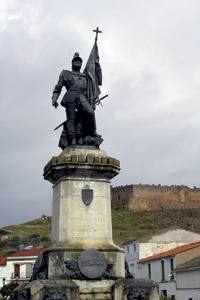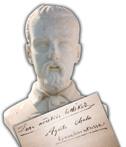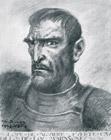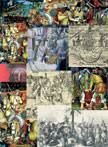Telesforo Monzon and Navarra
- Soon after Franco’s death the journalist Luz del Cielo (1976-IV) told Monzón that without Navarre there was no Basque Country; that with those who wanted to leave Navarre they did not want to travel “neither to Eibar nor to Malacca”. As for the future, Pamplona was our main city and... “To say Long Live Basque or Long Live Navarre was the same.”

Where did this fervent navarrese come from? Beginning with a fact remote in time but close in blood, the family had a humant ancestor born in 1764 in Pamplona, Tadeo Luis Monzón Ipenza, who in 1787 married María Merced Olaso Abara, born in Bergara, thus combining the lineage of Monzón with the Gambian ancestor Olaso of the Middle Ages. Mr. Tadeo Monzón was an honorable member of the famous association of knights in the service of the King of Seville and they had and have in the Olaso Tower the painting in which Tadeo and Maria Merced appear, giving an air of grandeur to the living room.
In accordance with the closest facts, the Estella statute of 1931 was approved by the municipalities of the four territories of the South Basque Country by an overwhelming majority of three; as Telesforo Monzón himself said –and many historians–, by betrayal and trickery of the lords of the right (Count of Rodezno) and the lords of the left (Emilio Azarola), on 19 June 1932, the Navarrese rejected, with fifty speeches, the Navarrese, the Navarrese, the Navarrese, the Navarre, the Navarre, the Navarre, the Navarre, the Navarre, the Navarre, the Navarre, the Navarre, the Navarre, the Navarre, the Navarre, the Navarre, the Navarre, the Navarre, the Navarre, the Navarre, the Irre, the other Irre, the Navarre, the Navarre, the Navarre, the Navarre, the Navarre, the Navarre, the Navarre, the Navarre, the Ir El trio de la bencina said that the three were Irujo, in the 1930 German comedy of the same title, three men in love with a woman as she was halatsu with Navarre. In addition to Navarre, Telesforo spoke about the importance of Navarre in Basque patriotism in Oiartzun, Durango and all of South Euskadi. However, Mola and Franco and the war broke out, and most of the Navarrese fought against the Basques under Spanish rule; and this was as painful as the war between the Basque brothers for Telesforo Monzón, although he did not hesitate to stand up against Spanish fascism.
"Monzón Irujori: I am with these Basque Navarrese, I am their brother; not with these other Basque militiamen. Yes, but these Basque Navarrese have killed the Basque warriors on their way from Navarre!"
Telesforo remembered very much what he and Irujo had experienced during the first days of the war, in the Gipuzkoa Provincial Council, both of which were members of the Gipuzkoa Defence Committee. Some Basque militiamen from Trincherpe brought some Basque Navarrese carlists to the Provincial Council. Monzón Irujori: I am with these Basque Navarrese, I am their brother; not with these other Basque militiamen. Yes, but these Navarrese Basques have killed Basque warriors on their way from Navarre to Honanza!
In September 1949, Basque dancer Besta Baiona. In addition to the dancers of the North, the dancers of the Alaia Peña de Muthí in Navarra, and their leader, Ignacio Ballez, who during the war stood out as the leader of the Navarrese roquetes. So Telesforo, seeking to regenerate and reconcile the hardened abominations among the Basques, goes to the Navarrese dancers who lacked bread for picnics with bread, which he gave to Ignazio Baleztena, who offered Telesforo wine bran in return, fulfilling the Christian mandate of Father Nuestro: “Forgive us our debts as we forgive our debtors.” There was a need for gestures to reconcile the Basques who had fought each other in the war.
In 1963, when the first famous Patriotic Day of the Sea was over, he told Manuel Irujo that he lived in a different world, beyond reflecting on who the representatives of the PSOE would be in the exiled Basque Government, he saw two mystics necessary and feasible unlike the war of 36, or if you prefer, with more hope of success: Mystique of Navarre and Basque: The north looked towards Navarre, and there were hopeful signs in Navarre. The same thing happened in 1967 after Christmas.
"When Franco died, he was in favor of the rupture, of giving peace in exchange for the recognition of the right to self-determination to the Spanish powers, and not to go to the Spanish Congress according to the rules of the game decided there"
When Franco died, he was in favor of the rupture, of giving peace in exchange for the recognition of the right to self-determination to the Spanish powers, and not of going to the Spanish Congress according to the rules of the game decided there. He was very reminded of what he had heard there during his term as a deputy from 1933 to 1936, to the Spanish politicians of the right and left: if you are Spanish zealots, respect the rules of the game of the representatives of the Spanish citizens, and if you are not Spanish, what are you doing here!
Without Navarre, Spanish being obligatory and not Basque, and the fact that the only political subject was citizens from Irun to Cádiz could not be accepted: The Black Eagle had its own like Pamplona, Guernica and Garazi, and from Atari to Ebro we had to build a Basque state. In April 1980, 24 deputies and senators of the People’s Union gathered in Leire to swear on the bones of the kings of Navarre that they would continue to fight for all of Navarre. Telesforo Monzon among them, master of ceremonies! They hoped that the relatives of the North would slide with those of the South before much. He lost, it's obvious, but he gave his life for his political ideas. The Basques deserve to be remembered!
Pako Sudupe, the writer.
Telesforo Monzon, author of the book The Patriotic Aristocrat (Vaccine, 2018)
Machiavelli made it well written that a military conquest comes with a political usurpation and then a cultural invasion. From the time of the conquest of Navarre, it seems that the author of the Prince was inspired by it. Thus, the Spaniards have been indoctrinating us for five... [+]
Carlos Garaikoetxea. The last reading I have made was a book written by Elixabete Garmendia under the title of lehendakari Lider bat. Highly recommended. I confess that he touched me and that he touched me. Not only because of the passages in it, but because I realized I knew... [+]
Frankismoaren errepresioa bere haragitan bizi izan zuen: 21 urte igaro zituen kartzelan, esklabo gisa ere aritu zen langile batailoietan, eta Meliton Manzanasek torturatu zuen. 99 urterekin hil da Usabiaga, bere ezkerreko ideiak inoiz alboratu gabe.
Ikusi aurretik ere nire buruari egiten diodan galdera da: Joxean’s Hileben izango ote da 2014ko film sonatuena? Seguruenik ez, baina urteko produkzio dibertigarrienen rankingean merezita sartuko da.
Oñatiko ARTaso arte taldeak Lope Agirreren inguruko hamabostaldia antolatu du gaurtik hasi eta urriaren 26ra arte. Agirreren historia eta bizitza “aldarrikatu eta ospatzeko” asmoz.
1534an Sevillan ontziratu zen, Amerikara bidean.
Kristau zaharra, aitoren semea, erregeren basailua eta Oñatikoa. Horrela zuen bere burua Lope Agirre konkistatzaileak, El Doradoren bila abiatu zen “marañonen erregeak”. Historiografiak traidore gisa baztertua, Oñatiko (Gipuzkoa) Araoz auzokoa... [+]



















